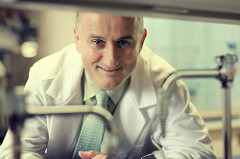Research Interests
Main group-based Lewis acids: Application in anion capture and catalysis
Over the years, our group has developed a strong expertise in the chemistry of Lewis acidic organo-main group compounds that we have used for the construction of supramolecular structures as well as for the complexation of small anions including fluoride and cyanide. In particular, we found that organoboron compounds, when decorated by organic substituents featuring ammonium or phosphonium groups can be used in water for the complexation and sensing of these potentially toxic anions. More recently, we have become interested in the chemistry of Lewis acidic organoantimony compounds and have discovered that their properties in water are far superior to those of boron compounds, both in terms of stability, anion affinity and photophysical response to the anion binding event. Our work on this topic shows that organoantimony species can be used for the complexation and sensing of fluoride in water at ppm or even sub ppm concentrations. Another application of our approach is in the domain of F18 positron emission tomography where some of our capture strategies are being applied to the radiolabeling of biomolecules via main group-based prosthetic groups which complex 18F-. Finally, we are now also investigating the use of these water tolerant Lewis acids in anion-binding catalysis.
Exploiting the non-innocence of antimony ligands: From organometallic catalysis to the photoreductive elimination of halogens
Although often regarded as heavy phosphine analogues, stibines behave as non-innocent ligands and display an unusual reactivity even when ligated to transition metals (M). This reactivity comes to light in their ability to undergo oxidation reactions without dissociation of the coordinated transition metal. This oxidation induces the formation of a M->Sb interaction resulting in a drastic Lewis acidity increase at the transition metal center. Using a family of gold stibine derivatives, we have demonstrated that such coordinated-stibine oxidation reactions can be used to afford potent hydroamination catalysts. Stibines are also non-innocent from a coordination point of view and can readily bind hard anions such as fluoride, without dissociation from the transition metal center. This anion binding events convert the antimony atom into a more strongly donating ligand, leading to an increase of electron density at the metal center. Our recent studies of this ligand-based coordination processes have shown that they can be exploited in reverse as a means to increase the electrophilic character of the transition metal center. This approach is illustrated by our work on antimony-platinum complexes and their conversion into active electrophilic hydroarylation and enyne cyclisation catalysts via antimony-centered anion abstraction reactions. Finally, we are also interested in the photochemistry of MSb complexes with a special focus on systems that support antimony-centered photoreductive processes.
Educational Background
- Ph. D., 1994, University of Texas at Austin
- Alexander von Humboldt Postdoctoral Fellow, 1994-1996, Technical University of Munich
- European Community Research Fellow (Habilitation), 1996-1998, Technical University of Munich
Awards & Honors
- Associate Editor for Chemical Science, 2019-present
- Distinguished Achievement Award in the category of Research
- University Distinguished Professor, 2019-present
- Third Annual Anton B. Burg Memorial Lecturer, University of Southern California, 2017
- The James A. Ibers Summer Lectures, Northwestern University, 2017
- Boulder Scientific Innovation Lecturer, Colorado State University, 2016
- F. Albert Cotton Award in Synthetic Inorganic Chemistry, 2016
- Editorial Board Member of Chemistry Select, 2016-present
- Editorial Board Member of Chem, 2016-present
- Vice-Chair (2014) and Chair (2016) of the Inorganic Chemistry Gordon Conference
- Appointed as Arthur E. Martell Chair of Chemistry, 2014
- Member of the Inorganic Syntheses board, 2013-present
- Fellow of the Royal Society of Chemistry, 2013
- Associate Editor for Organometallics, 2011-2019
- Fellows of the American Chemical Society, 2011
- Dalton Transactions North American Lectureship, 2009)
- NSF CAREER Award, 2001
- TMR European Commission Research Fellow, 1996
- Alexander von Humbodlt Fellow, 1994
Selected Publications
You, D.; Gabbaï, F. P. "Unmasking the Catalytic Activity of a Platinum Complex with a Lewis Acidic, Non-innocent Antimony Ligand" "Journal of the American Chemical Society 2017, 139, 6843-6846.
Chen, C.-H.; Gabbaï, F. P. "Exploiting the Strong Hydrogen Bond Donor Properties of a Borinic Acid Functionality for Fluoride Anion Recognition" Angewandte Chemie International Edition 2018, 57, 521-525.
Chen, C.-H.; Gabbaï, F. P. "Large-bite Diboranes for the m(1,2) Complexation of Hydrazine and Cyanide" Chemical Science 2018, 9, 6210-6218.
You, D.; Yang, H.; Sen, S.; Gabbaï, F. P. "Modulating the σ-Accepting Properties of an Antimony Z-type Ligand via Anion Abstraction: Remote-Controlled Reactivity of the Coordinated Platinum Atom" Journal of the American Chemical Society 2018, 140, 9644-9651.
Yang, M.; Tofan, D.; Chen, C.-H.; Jack, K. M.; Gabbaï, F. P. "Digging the σ‐hole of Organoantimony Lewis Acids by Oxidation" Angewandte Chemie International Edition 2018, Published online.

